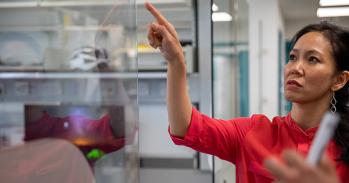
The largest genomic analysis of puberty timing in men and women conducted to date has identified 389 genetic signals associated with puberty timing, four times the number that were previously known.
The largest genomic analysis of puberty timing in men and women conducted to date has identified 389 genetic signals associated with puberty timing, four times the number that were previously known.
Our findings highlight the remarkable biological complexity of puberty timing, with likely thousands of genetic factors, in combination with numerous environmental triggers, acting together to control the timing of this key transition from childhood to adult life
John Perry
The study, published today in Nature Genetics and led by researchers from the Medical Research Council (MRC) Epidemiology Unit at the University of Cambridge and other scientists in the international ReproGen consortium, also found new genetic evidence linking earlier timing of puberty to higher risk of several cancers known to be sensitive to sex-hormones in later life, including breast, ovary and endometrial cancers in women, and prostate cancer in men. These influences remained after controlling for body weight, which is important as body weight itself influences both the timing of puberty and the risk of some cancers.
Dr John Perry, Senior Investigator Scientist from the MRC Epidemiology Unit and senior author on the paper, says: "Previous studies suggested that the timing of puberty in childhood was associated with risks of disease decades later, but until now it was unclear if those were circumstantial observations, for example secondary to other factors such as body weight.
“Our current study identifies direct causal links between earlier puberty timing itself and increased cancer risk. This link could possibly be explained by higher levels of sex hormones throughout life, but we need to do more work to understand the exact mechanisms involved. We aim to understand these disease links and thereby contribute to the prevention of diseases in later life."
The timing of puberty varies widely between individuals but tends to run closely within families. Earlier puberty timing may have advantages for some adolescents, for example for boys who engage actively in sports, but it appears to have largely negative effects on later health, such as higher risks of heart disease and some cancers.
By performing detailed assessments of genetic variants across the whole genome in 329,345 women, comprising data from 40 studies in the ReproGen consortium, UK Biobank, and consented 23andMe customers, this study identified 389 independent genetic signals for age at puberty in women. This observation was then confirmed in a further 39,543 women from the deCODE study, Iceland. Many of these genetic associations were also found to influence age at voice breaking, a comparable measure of puberty timing in men.
These findings shed light on the mechanisms that regulate puberty timing. Dr Perry adds: "These newly identified genetic factors explain one quarter of the estimated heritability of puberty timing. Our findings highlight the remarkable biological complexity of puberty timing, with likely thousands of genetic factors, in combination with numerous environmental triggers, acting together to control the timing of this key transition from childhood to adult life.”
Dr Ken Ong, also from the MRC Epidemiology Unit and joint senior author on the paper, says: "One of the more remarkable findings concerns the role of certain types of genes called imprinted genes, which are only active in your body when inherited specifically from one parent but not the other. We identified rare variants in two genes, which both lower the age of puberty when inherited from your father, but have no effect when inherited from your mother. This is intriguing as it suggests that mothers and fathers might benefit differently from puberty occurring at earlier or later ages in their children."
Reference
Felix R. Day, Deborah J. Thompson, Hannes Helgason et al. Genomic analyses identify hundreds of variants associated with age at menarche and support a role for puberty timing in cancer risk. Nature Genetics; 24 April 2017; DOI: 10.1038/ng.3841

The text in this work is licensed under a Creative Commons Attribution 4.0 International License. For image use please see separate credits above.




